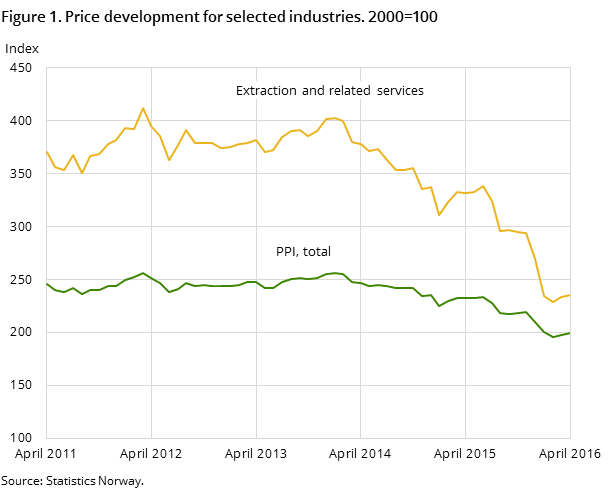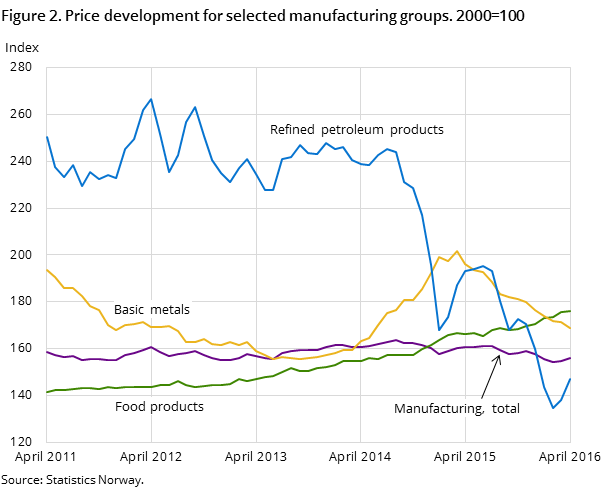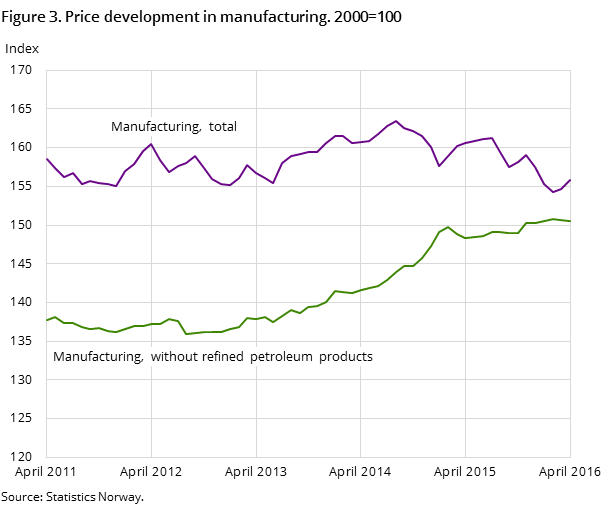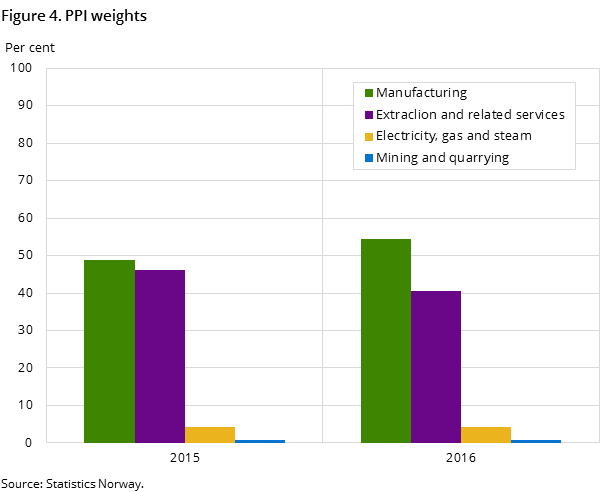Content
Published:
This is an archived release.
Higher prices on crude oil and petroleum products
The producer price index (PPI) rose 0.8 per cent from March to April. This was the second month in a row with an increase after a drop the three previous months. Higher prices on crude oil and refined petroleum products were the main contributors to the overall increase in the PPI.
| Industrial Classification | Index change in per cent | Index | Weights1 | |
|---|---|---|---|---|
| March 2016 - April 2016 | April 2015 - April 2016 | |||
| 1The weights are updated annually, and are valid for the entire year. | ||||
| Extraction, mining, manufacturing and electricity | 0.8 | -14.3 | 199.1 | 1 000.0 |
| Extraction and related services | 0.9 | -29.0 | 235.5 | 405.4 |
| Mining and quarrying | 0.9 | 6.9 | 183.1 | 7.6 |
| Manufacturing | 0.8 | -3.0 | 155.8 | 544.6 |
| Food products | 0.5 | 6.1 | 176.2 | 117.0 |
| Refined petroleum products | 6.7 | -23.7 | 147.1 | 79.1 |
| Basic metals | -1.3 | -14.0 | 168.9 | 45.7 |
| Machinery and equipment | 0.0 | 4.8 | 158.9 | 59.2 |
| Electricity, gas and steam | -0.2 | 8.1 | 227.5 | 42.4 |




The total price of oil and gas went up 1.2 per cent from March to April, thus rising for the second month in a row. The price of gas went down somewhat, but the contribution from the oil price led to an overall price increase on extraction of crude oil and natural gas. The twelve-month change from April 2015 to April 2016 was negative at minus 33.5 per cent, which was on a par with the two previous months.
Petroleum products and basic chemicals went in opposite directions
The prices of refined petroleum products went up 6.7 per cent and were therefore the main contributor to the price rise in the manufacturing industry, with 0.8 per cent. However, excluding refined petroleum, the prices for the manufacturing industry went down 0.1 per cent. Within the manufacturing industry, basic chemicals and metals were among the goods with a decrease in prices from March to April. The prices of basic chemicals went down by 3.7 per cent and this was the second month in a row with a price drop.
The prices of basic metals went down 1.3 per cent from March to April, thus continuing a downward trend. The last time there was a price increase for the metal industry was March 2015. The twelve-month change is now minus 14 per cent and this drop has mainly occurred in the export market, where global commodity prices are important. In the last twelve months, there has, among other things, been a drop in prices on aluminium and nickel, which form a considerable part of Norwegian metal industry.
Larger price increase in the domestic market
The price increase in the domestic market was 1 per cent overall from March to April and thus larger than in the export market. This can be explained by price drops in industries such as natural gas, basic chemicals and basic metals, which are more concentrated in the export market than the domestic market. In addition, the price increase of refined petroleum products was largely in the domestic market, where prices went up 8.1 per cent. However, a factor that offset the price increase in the domestic market was extraction and related services. The prices went down 0.4 per cent from March to April and have thus fallen 5.4 per cent from April 2015 to April 2016.
Updated weights in the PPIOpen and readClose
The PPI is calculated as a weighted average of price changes. In order for the PPI to reflect Norway’s industrial structure, the weights used to compute the price indices are updated every year. The new weights are implemented with the index for January. The weights represent industries’ production values in the previous year.
The trend from previous years, with a decline in the relative importance of oil-related industries in the Norwegian economy, is continuing in 2016. From 2015 to 2016, the weights of the industry ‘extraction of oil and natural gas’ fell from 46 to 41 per cent.
The manufacturing industries have however increased their influence on the total, up from 49 per cent in 2015 to 54 per cent in 2016. Manufacturing of food products has gained more weight and remains the biggest industry within manufacturing. Manufacturing of refined petroleum products is the second largest manufacturing group, although it has lost some weight in 2016. Machinery and equipment together with repair and installation of machinery have become more important and account for 11 per cent of the total.
The remaining weights are divided between electricity production, and mining and quarrying.
See StatBank and figure 4 for more details about the weights.
Additional information
Contact
-
Producer price index
E-mail: produsentpris@ssb.no
tel.: (+47) 21 09 40 00
-
Elisabeth Mælum
E-mail: elisabeth.maelum@ssb.no
tel.: (+47) 97 01 28 49
-
Morten Madshus
E-mail: morten.madshus@ssb.no
tel.: (+47) 40 90 26 94
-
Monika Græsli Engebretsen
E-mail: monika.graesli.engebretsen@ssb.no
tel.: (+47) 40 90 23 71
-
Håvard Georg Jensen
E-mail: havard.jensen@ssb.no
tel.: (+47) 40 90 26 86
